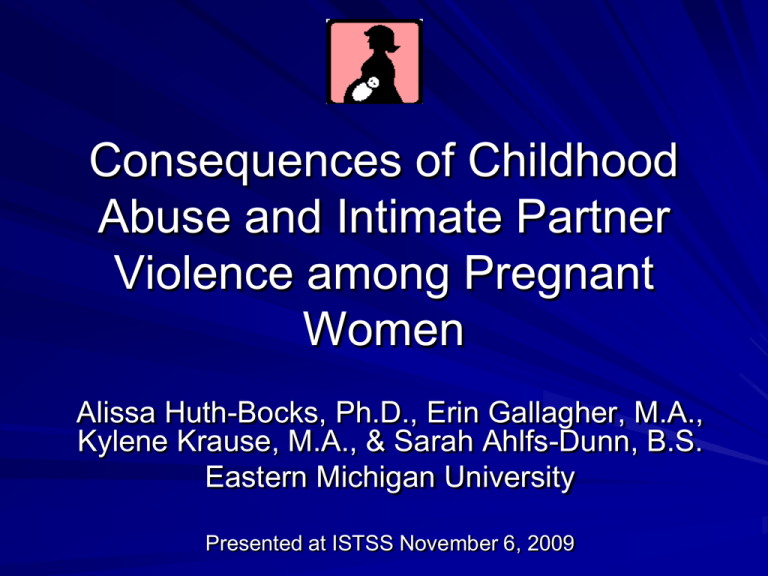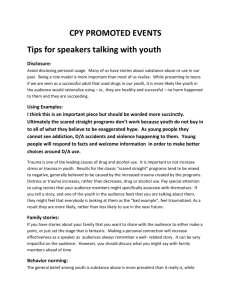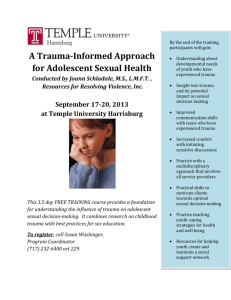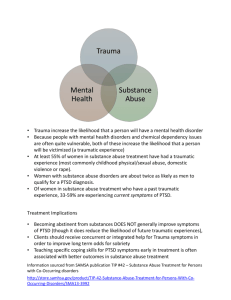
Consequences of Childhood
Abuse and Intimate Partner
Violence among Pregnant
Women
Alissa Huth-Bocks, Ph.D., Erin Gallagher, M.A.,
Kylene Krause, M.A., & Sarah Ahlfs-Dunn, B.S.
Eastern Michigan University
Presented at ISTSS November 6, 2009
Prevalence of Trauma among Women
Childhood interpersonal trauma (abuse and
neglect) is relatively common
– 12-20% of women report childhood sexual abuse
(Wijma et al., 2000)
– 10-25% of adults report childhood physical abuse
(WHO, 1999)
Half are girls (Trocme et al., 2001)
– Many more experience neglect, as neglect is the most
common form of childhood maltreatment
– Rates are much higher in clinical samples
Prevalence of Trauma among Women
Intimate partner violence (IPV) is also common
– About 12% in the last year (Straus & Gelles, 1986)
– About 20-38% in lifetime (Tjaden & Thoennes, 2000)
Up to 21% may experience IPV during
pregnancy (Peterson et al., 1997; Rosen et al., 2007)
– Higher rates during this time may be due to younger
age, increased jealousy by partner
IPV places women at risk for trauma symptoms
(Jones, Hughes, & Unterstaller, 2001), although less
is known about effects of emotional &
psychological IPV
Trauma Symptoms and PTSD
among Women
US current prevalence rate of PTSD is 3.5%, 6.8% for
lifetime rates (Kessler, Berglund et al., 2005; Kessler,
Chiu et al., 2005)
Women are at least 2X as likely to develop PTSD than
men (Breslau et al., 1998; Kessler et al., 1995)
– Current prevalence in women is ~5%, up to 12% lifetime
(Resnick et al., 1993)
– PTSD in women is more chronic (Breslau et al., 1998)
– Complex forms resulting from ongoing interpersonal victimization
more common in women & difficult to treat
Rates of PTSD and trauma symptoms in women differ by
type of trauma (e.g., sexual assault, physical abuse
highest?)
Trauma and PTSD during Pregnancy
Mixed results in terms of prevalence
– Some suggest lower or similar rates (3.5%; Smith et al.,
2006)
– Others suggest higher rates (6-8%) in prenatal clinic samples
(Loveland Cook et al., 2004) and upwards of 25% in low
income, community samples (Rosen et al., 2007)
Traumatic events may have different effects on
pregnant women vs. non-pregnant women (Smith et
al., 2006)
Pregnancy may be a trigger or exacerbate
symptoms: bodily experience, fear of childbirth,
medical procedures during prenatal care,
preparing to be mother
Critical implications for the health and well being of
the woman and baby
The Present Study
In sum, certain traumatic events may be more
likely to occur during pregnancy
Effects of current & past trauma may be
heightened during this time, yet
– Less is known about the effects of trauma on women
during pregnancy
Very little is known about trauma symptoms
resulting from other forms of trauma not typically
captured using a diagnostic approach (Criterion
A)
This study examined associations between
various forms of interpersonal traumas on PTSD
symptoms in high-risk pregnant women
Participants
120 pregnant women (in last trimester) from
community in southeastern Michigan
Average age = 26 (Range = 18-42, SD = 5.7)
Racial/Ethnic self-identification:
–
–
–
–
47% African American
36% Caucasian
13% Biracial
4% other ethnic groups
Marital Status:
–
–
–
–
64% single (never married)
28% married
4% separated
4% divorced
30% first time mothers
Participants
Highest level of education obtained:
– 20% high school diploma/GED or less
– 44% some college or trade school
– 36% college degree
Median monthly income = $1,500 (range = $0 $10,416)
Involvement in Social Services:
–
–
–
–
88% WIC
62% food stamps
90% public health insurance
20% public supplemental income
Procedures
Participants were recruited via fliers, mostly from:
–
–
–
–
–
community-based health clinics (23%)
Women, Infants, and Children (WIC) program (18%)
regional-level university and community college (16%)
“community baby shower” (11%)
word of mouth (11%)
Interviewed in last trimester of pregnancy at home
(78%) or at research office (22%)
– 2 ½ to 3 hours
– Compensated with a $25 gift card
Childhood Trauma Questionnaire
(CTQ; Bernstein & Fink, 1998)
28-item self-report inventory designed to assess
experiences of five types of childhood maltreatment:
– emotional, physical, and sexual abuse
– emotional and physical neglect
5 items each per subscale, with scores ranging from
5-25 for each
– 3 item minimization/denial scale not used in analyses
Higher scores indicate greater severity of childhood
maltreatment
Childhood Trauma Questionnaire
In the present study, coefficient alphas were:
–
–
–
–
–
–
Emotional abuse = .91
Physical abuse = .90
Sexual abuse = .95
Emotional neglect = .92
Physical neglect = .84
Total CTQ = .95
Inter-correlations ranged from r = .35 (sex abuse &
physical abuse) to r = .81 (emotional abuse &
emotional neglect)
Emotional abuse and neglect scales were
combined for emotional maltreatment total; all
others were retained
Conflict Tactics Scale – 2
(CTS-2; Straus, Hamby, & Warren, 2003)
78-item questionnaire designed to assess four
types of intimate partner violence:
– psychological, physical, sexual violence, as well as
physical injuries resulting from violence
– Only 33 items assessing victimization were used here
Violence was assessed for multiple time periods;
only IPV during the current pregnancy was used
here
Higher scores indicate greater IPV severity
Conflict Tactics Scale – 2
In the present study, coefficient alphas were:
–
–
–
–
–
Psychology violence = .79
Physical violence = .67
Sexual violence = .56
Injuries from violence = .44
Total Pregnancy DV = .84
Inter-correlations of subscales ranged from r = .10
(physical violence & sexual violence) to r = .98
(physical violence & injuries)
Physical violence & injury subscales were
combined (alpha = .80); others were retained
PTSD Checklist-C
(PCL-C; Weathers et al., 1993)
17-item self-report designed to assess DSM-IV
PTSD symptoms:
– Intrusions/re-experiencing
– avoidance
– hyperarousal
Different cut-off scores have been suggested for
diagnoses; this study used it to assess severity
of symptoms (dimensional)
Higher scores indicate greater trauma
symptoms
PTSD Checklist-C
Recent study suggested 4 factors instead of 3
with an IPV sample (Krause et al., 2007); alphas
in the present study were:
–
–
–
–
–
Re-experiencing/intrusions = .83
Avoidance = .61 (2 items)
Dysphoria = .76
Hyperarousal = .63 (2 items)
Total PCL = .87
Inter-correlations ranged from r = .17 (avoidance
& hyperarousal) to r = .63 (intrusion & dysphoria)
All scales were retained separately
Results: Rates of Trauma
Child Emotional Abuse
68%
Child Physical Abuse
58%
Child Sexual Abuse
28%
Child Emotional Neglect
75%
Child Physical Neglect
49%
Physical and/or Sexual IPV
during Pregnancy
24%
Psychological, Physical and/or
Sexual IPV during Pregnancy
81%
Results: Associations between
Childhood Trauma and IPV
Psych
IPV
Physical
IPV
Sexual
IPV
Total
IPV
CTQ
Emotional
.25**
.18
.20*
.26**
CTQ
Phy Abuse
.17
.25**
-.06
.18*
CTQ
Phy Neg
.15
.02
.20*
.14
CTQ
Sexual
.05
-.05
.17
.05
CTQ
Total
.24*
.16
.18
.24*
* p < .05. ** p < .01.
Results: Associations between
Childhood Trauma & PTSD symptoms
Intrusions Avoidance Dysphoria
Hyperarousal
Total
Sxs
CTQ
Emotional
.37**
.33**
.38**
.18
.42**
CTQ
Phy Abuse
.29**
.32**
.29**
.19*
.35**
CTQ
Phy Neg
.32**
.29**
.26**
.20*
.34**
CTQ
Sexual
.27**
.27**
.11
.19*
.24**
CTQ
Total
.42**
.35**
.37**
.20*
.44**
* p < .05. ** p < .01.
Results: Childhood Trauma
& PTSD symptoms
Standardized
Beta
F-value
Adjusted R2
Step One:
Age
Income
-.25**
-.06
4.47*
.06*
Step Two:
Emotional
Phy Abuse
Phy Neglect
Sexual
.22
.07
.17
.05
6.50**
.23**
* p < .05. ** p < .01.
Results: Associations between
IPV and PTSD symptoms
Intrusions Avoidance Dysphoria
Hyperarousal
Total
Sxs
Psych
IPV
.36**
.18
.35**
.18
.38**
Physical
IPV
.17
.09
.31**
.05
.24**
Sexual
IPV
.15
.14
.09
-.09
.11
Total
IPV
.32**
.17
.35**
.12
.35**
* p < .05. ** p < .01.
Results: IPV & PTSD symptoms
F-value
Adjusted R2
-.25**
-.06
4.48*
.06*
Step Two:
Psychological .46**
Physical
-.11
Sexual
-.08
5.30**
.16**
Standardized
Beta
Step One:
Age
Income
* p < .05. ** p < .01.
Results: Both Types of Trauma
& PTSD symptoms
Standardized
Beta
F-value
Adjusted R2
Step One:
Age
Income
-.25**
-.06
4.47*
.06*
Step Two:
Total IPV
.32**
7.75**
.15**
Step Three:
Total CTQ
.39**
12.36**
.29**
* p < .05. ** p < .01.
Conclusions
It is critically important to assess, identify, and treat
emotional & psychological forms of interpersonal
violence
– Currently they do not meet criterion A1, which requires a
threat to physical integrity
– Threats to emotional integrity (self) appear to result in
PTSD symptoms, though the syndrome may look
different ?
– More research is needed to examine clusters and
severity of symptoms after exposure to psychological
trauma, especially of the interpersonal, chronic type
Revision of A1 should be further considered
Criterion A2 likely still applies (“fear, helplessness,
& horror”)
Conclusions
Both types of interpersonal violence (childhood
maltreatment & adult IPV) were important
predictors
Would results have been similar in non-pregnant
women?
– Pregnancy is a unique, highly “relational” time
Providers working with low-income pregnant
women need to assess broad range of traumatic
experiences & sequelae
Conclusions
Limitations
– Relatively small sample (but a unique one)
– High rates of trauma overall, but restricted range of
more severe types, especially with current IPV
Future Research
– Continue to look more closely at effects of different
types of trauma
– Examine possible mediators & moderators
– Use the PCL both dimensionally & categorically with
appropriate cut-offs
– Examine post-partum outcomes with follow-up data
Acknowledgements
We are enormously grateful to the families
participating in this study who allowed us to visit
their homes and learn about their circumstances
We are also very grateful to the graduate and
undergraduate research assistants who helped
collect these data
We thank our funding sources for this study
– Eastern Michigan University Office of
Research Development
– American Psychoanalytic Association
Continuing Medical Education Commercial
Disclosure Requirement
I, Alissa Huth-Bocks, have no commercial
relationships to disclose.




